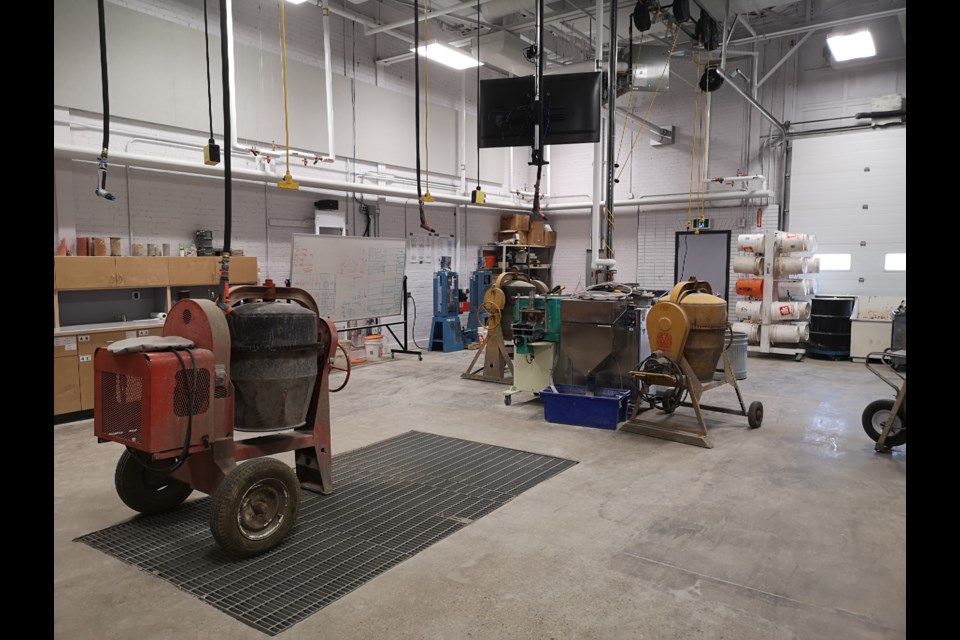Sask. Polytechnic held its annual open house event on the week of Oct. 23 to 26, which allowed prospective students to learn more about the wide range of programs offered by the school.
At the event, civil engineering technologies instructor Shawn Lamothe provided a tour and some information on courses offered by Sask. Polytechnic. His program was one of those highlighted during the event.
“Our program is five semesters long, and it does include an eight-month work term,” Lamothe said about the civil engineering technologies program.
“(Students) come in and do their first two semesters. The first two semesters are going to be introduction into their basic math, soils, (and) the basic stuff they could potentially be doing as an introductory student going out into the workforce,” he said.
Sask. Polytechnic balances theory with hands-on learning. Lamothe said the hands-on component makes up about 60 per cent of the course load each semester, but the balance varies between courses.
Lamothe said this balance usually translates into one or two hours in the classroom followed by about three hours with hands-on projects. When it comes to learning new theory, the lesson is typically followed by the immediate opportunity to test core concepts in an adjacent lab.
“Things like our concrete, soils, asphalt, and hydraulics programs are very hands-on. We’re going to be coming in, doing the actual testing, seeing what data we get, processing that data, and putting in in a real-world scenario,” Lamothe said.
“The other part is theory. People always assume (we) don’t have as much math or as much of the theoretical basis as you do (in university programs), but we have a lot of the theory here as well,” he added.
“From there, (the students) are going… into their work term. We’re going to give them all their employability skills they need to get onto an entry-level position. They’ll go out onto a work term, get paid for eight months, then they’ll come back here, and we’ll get into more of the theory side of things.”
The goal is to ensure graduating students are competent in their field and immediately employable. To achieve this, students are given the opportunity to work on real-world applications which culminates in a capstone project.
“Their capstone project is going to be something they have to build on their knowledge that they’ve learned so far,” Lamothe said. Students choose a project based on their specific interests.
One project of note involves a student striving to find a cheaper alternative to self-healing concrete. The concrete, according to Lamothe, will fix itself with no further measures needed, should the student be successful in their effort. The goal is to reduce costs by as much as 1400 – 1500 per cent.
Another student seeks to produce greener concrete using glass powder, such as the waste material produced at Potters Industries Canada in Moose Jaw.
“We have somebody putting glass powder in. Glass powder kind of has similar properties to the Portland cement that’s currently in concrete, so we can replace some of that cement with glass powder which is… a waste product from somewhere else,” he stated.
In another project, students are working on drainage solutions to be applied in Wakamow Valley. Such projects include concrete works and the rehabilitation of waterways.
“(This is) stuff that could potentially be done by city engineers; they’re going to go out and do it. When they do that, it’s going to be a real, workable product that they provide us,” Lamothe said.
Some of the smaller course projects include the design of small structures, drainage systems, and management projects.
In the program’s management projects, students are “actually taking bids… and taking that information (to) actually (bid) on a real-world project, something they would be doing in industry if they choose to go that path,” Lamothe explained.
“We have such a wide array of what these students are capable of doing when they come out of there. So, anything from working in a water treatment plant to project management… doing Water Security Agency projects… there’s so many different positions.”
Sask. Polytechnic covers a wide range of specialized areas of study, and this helps align students with employers who are looking for specific skills not otherwise acquired in broader programs.
“It’s nice that we can tailor our actual program to meet the needs of industry to fill these gaps that maybe aren’t specifically caught by other programs,” Lamothe said.
Throughout the program, students have ample support from course instructors to help resolve any questions and to assist in their learning. One benefit to studying at Sask. Polytechnic is this direct access to instructors, which isn’t typically offered through university courses. These offices are located in a single corridor and instructors have an open-door policy, which makes learning a lot easier.
To contact Shawn Lamothe to book a tour or for more information specific to the civil engineering technologies program at Sask. Polytechnic, call 306-630-2660 or email [email protected].
Sask. Polytechnic is located at 600 Saskatchewan Street West and can be reached at 1-866-467-4278.
In response to some providers blocking access to Canadian news on their platforms, our website, MooseJawToday.com will continue to be your source for hyper-local Moose Jaw news. Bookmark MooseJawToday.com and sign up for our free online newsletter to read the latest local developments.




